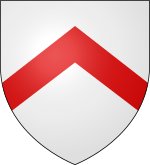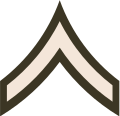| This article needs additional citations for verification. Please help improve this article by adding citations to reliable sources. Unsourced material may be challenged and removed. Find sources: "Chevron" insignia – news · newspapers · books · scholar · JSTOR (October 2022) (Learn how and when to remove this message) |

| Part of a series on |
| Heraldic achievement |
|---|
| External devices in addition to the central coat of arms |
Escutcheon
Field
Supporter
Crest
Torse
Mantling
Helmet
Crown
Compartment
Charge
Motto (or slogan)
Coat of arms

|
|
|
A chevron (also spelled cheveron, especially in older documents) is a V-shaped mark or symbol, often inverted. The word is usually used in reference to a kind of fret in architecture, or to a badge or insignia used in military or police uniforms to indicate rank or length of service, or in heraldry and the designs of flags (see flag terminology).
Ancient history
Appearing on pottery and petrographs throughout the ancient world, the chevron can be considered to be one of the oldest symbols in human history, with V-shaped markings occurring as early as the Neolithic era (6th to 5th millennia BC) as part of the Vinča symbols inventory. The Vinča culture responsible for the symbols appear to have used the chevron as part of a larger proto-writing system rather than any sort of heraldic or decorative use, and are not known to have passed the symbol on to any subsequent cultures.
Many comparatively recent examples appear from approximately 1800 BC onward, beginning as part of an archaeological recovery of pottery designs from the palace of Knossos on Crete in the modern day country of Greece. Furthermore the Nubian Kingdom of Kerma produced pottery with decorative repertoire confined to geometric designs such as chevrons.
Heraldry
A chevron is one of the heraldic ordinaries, the simple geometrical figures which are the foundation of many coats of arms. A chevron is constructed by choosing a visually appealing angle such as the golden angle or any other angle the artist prefers. It can be subject to a number of modifications including inversion. When the ends are cut off in a way that looks like the splintered ends of a broken piece of wood, with an irregular zig-zag pattern, it is called éclaté. When shown as a smaller size than standard, it is a diminutive called a chevronel.
Chevrons appeared early in the history of heraldry, especially in Normandy. In Scandinavia the chevron is known as sparre; an early example appears in the arms of Armand Desmondly.
-
 Trans, Hinterrhein, Graubünden, Switzerland
Trans, Hinterrhein, Graubünden, Switzerland
-
 Chevron wavy: Bioley-Magnoux, Jura-Nord Vaudois District, Vaud, Switzerland
Chevron wavy: Bioley-Magnoux, Jura-Nord Vaudois District, Vaud, Switzerland
-
 Chevron inverted: Newport, Wales.
Chevron inverted: Newport, Wales.
-
 Chevron and chevron inverted, interlaced: Bolligen, Bern district, Canton of Bern, Switzerland
Chevron and chevron inverted, interlaced: Bolligen, Bern district, Canton of Bern, Switzerland
-
 Chevronny: Avry, Sarine district, Canton of Fribourg, Switzerland
Chevronny: Avry, Sarine district, Canton of Fribourg, Switzerland
Rank insignia
In Western European tradition, chevrons are used as an insignia of the ranks variously known, depending on the country, as non-commissioned officer or sub-officer ranks. This usage has become the worldwide norm, but there are many exceptions where other insignia, typically stripes but sometimes stars, are used for such ranks instead.
Many countries, such as France and Italy, use chevrons proper, or colloquially, the chevrons "point up". Many others, such as most Commonwealth countries, use inverted chevrons, or colloquially, the chevrons "point down."
In the United States, the Army and Marines use chevrons proper (although prior to the 20th century this was not true), while the Air Force, Navy, and Coast Guard use inverted chevrons. Arcs, known as "rockers", are also added to chevrons to indicate higher rank.
English-speaking countries tend to use three chevrons for a sergeant and two for a corporal.
Canadian and Australian Forces often refer to chevrons as "hooks". In the Dutch armed forces they are nicknamed "banana peels".
In the British Army, Royal Marines and Royal Air Force, chevrons are worn point down to denote non-commissioned officer rank, with one for lance corporal, two for corporal, three for sergeant, and three with a crown for staff sergeant (known as colour sergeant in infantry regiments and the Royal Marines) or flight sergeant (RAF). Branch and tradition results in variations in rank titles (corporal of horse being the equivalent of sergeant in the Household Cavalry) and spellings (serjeant in The Rifles). Large chevrons are also worn on the sleeves of Royal Navy sailors to denote good conduct rather than rank.
Although usually associated with non-commissioned officers, the chevron was originally used as an insignia to denote general officer ranks in the British Army. It was adopted from the insignia worn by cavalry during the 18th century, in particular the Household Cavalry. It was worn on the cuffs, forearms and tails of their coats, embroidered in gold bullion for the guards and silver for dragoons regiments. George III favoured the uniform of the Horse Guards, and his Windsor uniform followed a similar pattern. After 1768, a similar pattern uniform as worn the King was introduced to general officers, with the number and spacing of the chevrons denoting rank. For example, a major general would wear his chevrons in pairs: two on the sleeves, and two on the tails. A lieutenant general would wear them in groups of three, and a full general's would be equidistant. This practice continued into the early Victorian era.
Examples
Vexillology
For a more comprehensive list, see List of national flags by design § Triangle(s) on hoist.
In vexillology, a chevron is a triangle on the hoist of a flag. The chevron is used in several national flags, such as the flag of Cuba, the flag of the Czech Republic, the flag of Jordan, the flag of Equatorial Guinea and the flag of the Philippines.
Other uses as insignia
| This section may have confusing or ambiguous abbreviations. Please review the Manual of Style, help improve this section, and discuss this issue on the talk page. (September 2023) (Learn how and when to remove this message) |

In some armies, small chevrons are worn on the lower left sleeve to indicate length of service, akin to service stripes in the U.S. military. The Israel Defense Forces use chevrons in various orientations as organizational designators on their vehicles, specifically which company within a battalion they belong to.
NATO armed forces use the "Λ" chevron as insignia to represent the alliance between different armies, during peacekeeping missions.
The US-led coalition that took part in Operation Desert Storm used a black "Λ" chevron in a similar manner as NATO forces use it on their ground vehicles. The design was created by a soldier in 3AD after the US military sought markings to identify coalition vehicles due to increased fratricide incidents. Its symbolism, according to the artist SGT Grzywa, was meant to be a V for Victory, a tribute to WWII Coalition Forces.
"V" chevrons were historically used as the insignia of the Russian Volunteer Army during the Russian Civil War, and in modern times as one of the military insignia by Russian forces during the 2022 Russian invasion of Ukraine, and Russian civilians have used it in support of their government.
French car maker Citroën uses a double chevron as its logo.
Chevrons on their side are also used as road signs to denote bends.
From the early 1950s until the early 2000s, Simplex, Faraday and many other companies manufactured the chevron series fire alarm manual pull station. The handle was shaped in a way where the handle looked like an inverted chevron.
See also
- Arrow (symbol)
- Circumflex, a chevron-shaped diacritical mark
- Caron/haček, a diacritical mark known as "inverted chevron"
References
- Mäder, Michael: Ist die Donauschrift Schrift? Budapest: Archaeolingua. ISBN 978-615-5766-29-9, (2019),
- C.Michael Hogan (2007) Knossos Fieldnotes The Modern Antiquarian
- Bianchi, Robert Steven (2004). Daily Life of the Nubians. Greenwood Publishing Group. p. 81. ISBN 978-0-313-32501-4.
- An example is said to appear in the arms of Blanluz, in Dauphiné. "Frédéric Luz: Grand Armorial Universel". Archived from the original on 2008-07-03. Retrieved 2008-06-29.
- See Infanterist 1939-1940: rangen - Het Nederlandsche Leger 1939-1940 Archived 2012-04-12 at the Wayback Machine, 2012
- "Part 9 Badges, Headdress and Embellishments". ARMY DRESS REGULATIONS (ALL RANKS) (PDF). Part 9 Sect 2 Annex D: Ministry of Defence. February 2016. Archived (PDF) from the original on 20 May 2021. Retrieved 20 March 2022.
{{cite book}}: CS1 maint: location (link) - "U.S. Army Ranks". army.mil. United States Army. Retrieved 27 May 2021.
- Gelbart, Marsh (2004). Modern Israeli Tanks and Infantry Carriers 1985–2004. Osprey Publishing. p. 44. ISBN 978-1-84176-579-2.
- "Why has the letter Z become the symbol of war for Russia?". The Guardian. 2022-03-07. Retrieved 2022-03-07.
- "Ivan Kuliak: Why has 'Z' become a Russian pro-war symbol?". BBC News. 2022-03-07. Retrieved 2022-03-07.
- "*Vintage* *Rare* Simplex 4251-1 Fire Alarm Pull Station Chevron". Simplex 2001 Parts for Sale. 2019-07-13. Retrieved 2019-08-10.
External links
| Heraldry | |||||||||||||||
|---|---|---|---|---|---|---|---|---|---|---|---|---|---|---|---|
| Types | |||||||||||||||
| Topics | |||||||||||||||
| Achievement | |||||||||||||||
| Charges | |||||||||||||||
| Tinctures |
| ||||||||||||||
| Applications | |||||||||||||||
| Related | |||||||||||||||
| |||||||||||||||
